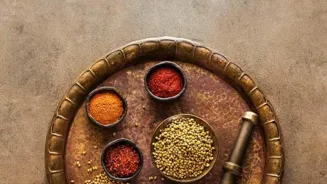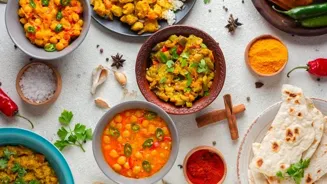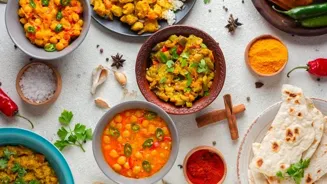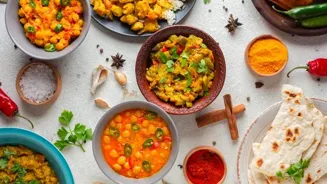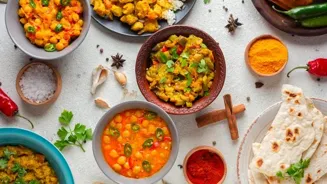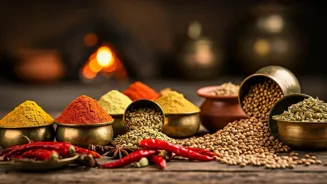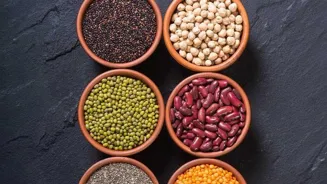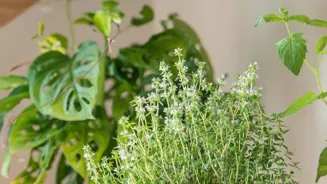Discover the magic of Indian spices! Elevate your dishes with Turmeric, Cumin, Coriander, Ginger, and Cardamom. Read more for flavor explosion!
Namaste, food lovers! Are you looking to add some zing and
zest to your everyday cooking? Well, look no further than your very own Indian spice cabinet!
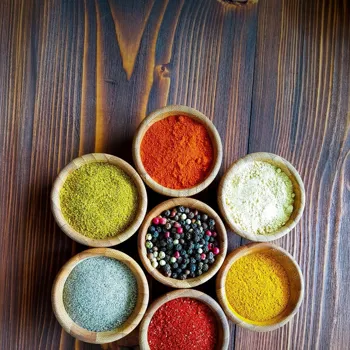
India, the land of vibrant colours and diverse cultures, is also a treasure trove of aromatic spices that can transform even the simplest dish into a culinary masterpiece. Forget bland and boring – get ready for a flavour explosion!
Today, we're diving into the world of Indian spices and highlighting five must-haves that will elevate your vegetarian cooking to new heights. These aren't just your average spices; they're flavour bombs waiting to be unleashed! So, ditch the ready-made sauces and embrace the art of spicing.
Trust us, your taste buds will thank you!
Turmeric: a versatile super spice for vibrant dishes and health benefits
Let's kick things off with Turmeric, or "Haldi" as we lovingly call it. This golden spice is a staple in almost every Indian household, and for good reason. Turmeric boasts a warm, earthy flavor and a vibrant yellow hue that instantly brightens up any dish.
But it's not just about aesthetics; Turmeric is packed with curcumin, a powerful antioxidant with numerous health benefits. From soothing sore throats to boosting immunity, Turmeric is a true super spice. In the kitchen, Turmeric is incredibly versatile.
Add a pinch to your rice for a beautiful colour and subtle flavour, or include it in your vegetable curries for depth and complexity. You can even brew a comforting cup of "Haldi Doodh" (Turmeric Milk) before bed for a restful night's sleep. Just remember, a little goes a long way!
Too much Turmeric can overpower the other flavours in your dish. Start with a small amount and adjust according to your taste. Experiment with different combinations and discover the magic of Turmeric in your cooking. It’s a spice rack essential that is always stocked in the kitchen.
Cumin: a versatile spice enhancing flavor and aiding digestion, essential in Indian cuisine
Next up, we have Cumin, or "Jeera," a spice that adds a warm, earthy, and slightly bitter note to your dishes. These tiny, brown seeds are packed with flavour and aroma, and they can be used whole, ground, or tempered in oil to release their full potential.
Cumin is a key ingredient in many Indian spice blends, such as Garam Masala and Curry Powder, and it plays a crucial role in flavouring dals, vegetable curries, and even snacks like samosas and pakoras. But Cumin isn't just about flavour; it also aids digestion and helps to relieve bloating.
It’s the perfect addition for a healthy gut. To get the most out of your Cumin, try toasting the seeds in a dry pan before grinding them. This will enhance their flavour and aroma, giving your dishes an extra boost.
You can also temper whole Cumin seeds in hot oil or ghee to create a flavourful base for your curries. And don't forget to experiment with roasted Cumin powder, which has a more intense flavour than regular Cumin powder.
You can sprinkle roasted Cumin powder over raita, salads, or even roasted vegetables for a delicious and aromatic twist. Cumin is definitely a flavor enhancer in your dishes which is a must try .
Coriander: Seeds for flavor, leaves for garnish in Indian cooking
Now, let's talk about Coriander, or "Dhaniya," a spice that comes in two forms: seeds and leaves. Coriander seeds have a warm, citrusy flavour and are often used in spice blends and curries. Coriander leaves, on the other hand, have a fresh, herbaceous flavour and are typically used as a garnish.
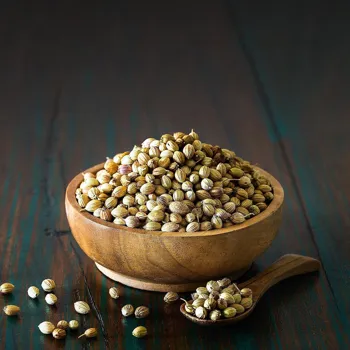
Both forms of Coriander are essential in Indian cooking, and they can add a unique layer of complexity to your dishes. Coriander seeds are particularly useful for thickening sauces and adding a depth of flavour to curries.
You can also roast and grind Coriander seeds to create a flavourful powder that can be used as a rub for roasted vegetables. Coriander leaves are a fantastic garnish for almost any Indian dish. Sprinkle them over your curries, dals, or rice for a burst of fresh flavour and colour.
You can also add Coriander leaves to raita, chutneys, or salads for a refreshing twist. And don't forget to use the stems! Coriander stems are packed with flavour and aroma, and they can be added to soups, stews, or curries for an extra boost.
Fresh coriander is usually added to the cooked dishes to add more flavor into the dish.
Ginger adds flavor and health benefits to dishes worldwide
Moving on to Ginger, or "Adrak," a rhizome that adds a pungent, spicy, and slightly sweet flavour to your dishes. Ginger is a common ingredient in Indian cuisine, and it's used in everything from teas and soups to curries and stir-fries.
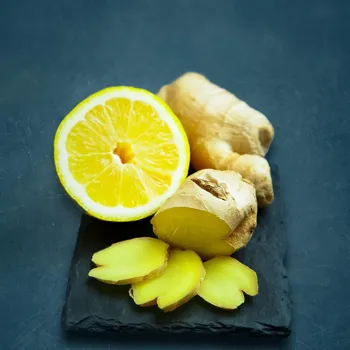
But Ginger isn't just about flavour; it also has numerous health benefits. It's known for its anti-inflammatory properties, and it can help to relieve nausea and indigestion. Ginger can be used fresh, dried, or powdered. Fresh Ginger is best for adding a strong, pungent flavour to your dishes.
Dried Ginger, also known as Sonth, has a milder flavour and is often used in baked goods and spice blends. Ginger powder is a convenient option for when you don't have fresh Ginger on hand. To use fresh Ginger, simply peel and grate or mince it.
You can add it to your dishes at the beginning of cooking to infuse them with its flavour, or you can add it towards the end for a more pronounced kick. Ginger tea is a popular remedy for colds and flu, and it can also help to soothe an upset stomach.
Ginger is one ingredient that is available almost everywhere.
Cardamom: Sweet floral green & smoky black types elevate dishes
Our final spice is Cardamom, or "Elaichi," a spice that has an intense aroma and flavour. Cardamom comes in two main varieties: green and black. Green Cardamom has a sweet, floral flavour and is often used in desserts and sweet dishes.

Black Cardamom, on the other hand, has a smoky, more intense flavour and is typically used in savory dishes. Cardamom is a relatively expensive spice, but a little goes a long way. Just a few pods can add a significant amount of flavour and aroma to your dishes.
To use Cardamom, you can either crush the pods slightly to release their flavour, or you can grind the seeds inside the pods into a powder. Cardamom is often used in Indian sweets like Kheer and Gulab Jamun. It is also added into tea, to give a different flavor.
Cardamom is also a key ingredient in Biryani, where it adds a complex and aromatic flavour to the rice and vegetables. And don't forget to use Cardamom in your Masala Chai! A few crushed Cardamom pods can transform your regular cup of tea into a fragrant and comforting beverage.
Cardamom gives rich texture and delicious flavour and a must try.
Experiment with Indian spices for flavorful vegetarian dishes, elevate cooking
So there you have it – five must-try Indian spices that will add a burst of flavour to your vegetarian dishes. From the earthy warmth of Turmeric to the fragrant sweetness of Cardamom, these spices are sure to elevate your cooking to new heights.
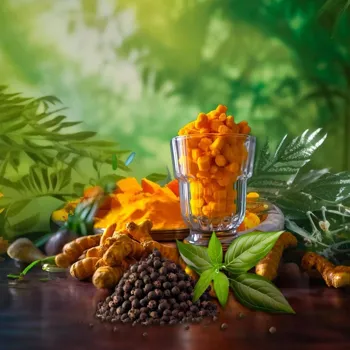
Don't be afraid to experiment with different combinations and find what works best for you. The key is to start small and adjust according to your taste. With a little practice, you'll be able to create your own signature spice blends and impress your friends and family with your culinary skills.
Happy cooking! And remember food is not just about filling your belly but also adding flavour into your life.
AI Generated Content. Glance/InMobi shall have no liability for the content